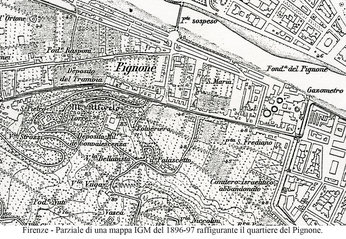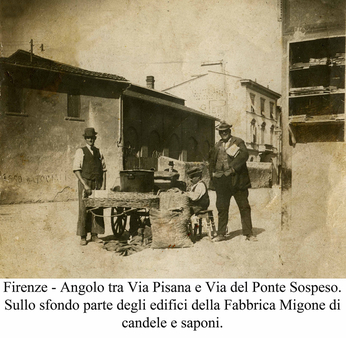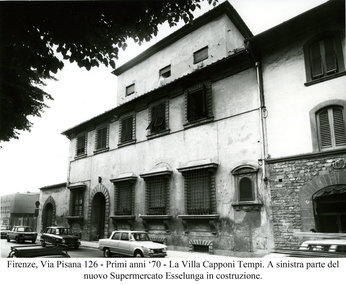
THE PIGNONE DISTRICT OVER TIME
 The history of the Pignone neighbourhood begins in Roman Florence. It was a fortified town, on the banks of a river, connected to the other side of the Arno by the forerunner of the Ponte Vecchio and a long straight road: the via Pisana. Fields, the first orchards and the first houses, a church and a little port: this was the Pignone of this time. The first documentary evidence of Monte Beni, today Monte Oliveto, dates to the tenth and eleventh centuries. In 1040 we find traces of the little harbour of Anconella and, from 1218, the creation of the Navicellai, expert navigators of the Arno whose well-to-do members would often lend their boats to the community for the celebrations of the patron saint of the town, San Giovanni. The town expanded between the XIII and XIV centuries with the construction of a new city wall, called the Mura, and Porta di Verzaia, today Porta San Frediano, which separated the people of the city from those of the country. The Benedictine Monastery of Monte Oliveto was subsequently constructed and, after a flood, walls were also built along the river, as far as Ponte alla Carraia. Torre di Santa Rosa acted as a watchtower for monitoring the goods on the water while the little port of Navaioli became progressively busier. The strengthening of the river’s embankment made mooring easier. Its truncated cone-shape construction, technically called ‘pignone’, lent its name to the entire area from the 18th century onwards. Along the Arno, just outside the walls, was Sardigna, the Roman name for the derelict area that acted as both a safe area and a dumping ground. On the other side of the Arno was Borgo di Verzaia, which extended for around two miles along via Pisana. Attached to it was Borgo dei Navicellai. In 1529 the Spanish and papal troops besieged Florence in order to restore the Medici to power, ordering the demolition of all constructions within a radius of one mile of the walls. This wiped out Borgo di Verzaia and saw the port moved to Ponte della Vittoria. At the end of the 1500s, the only constructions in Verzaia were the Oratorio del Chiesino, the Tabernacolo del Crocifisso, the Villa of Neri Capponi and the group of houses of the Navicellai of Anconella, where in 1632 the lazaretto and the mass grave for the plague were created.
The history of the Pignone neighbourhood begins in Roman Florence. It was a fortified town, on the banks of a river, connected to the other side of the Arno by the forerunner of the Ponte Vecchio and a long straight road: the via Pisana. Fields, the first orchards and the first houses, a church and a little port: this was the Pignone of this time. The first documentary evidence of Monte Beni, today Monte Oliveto, dates to the tenth and eleventh centuries. In 1040 we find traces of the little harbour of Anconella and, from 1218, the creation of the Navicellai, expert navigators of the Arno whose well-to-do members would often lend their boats to the community for the celebrations of the patron saint of the town, San Giovanni. The town expanded between the XIII and XIV centuries with the construction of a new city wall, called the Mura, and Porta di Verzaia, today Porta San Frediano, which separated the people of the city from those of the country. The Benedictine Monastery of Monte Oliveto was subsequently constructed and, after a flood, walls were also built along the river, as far as Ponte alla Carraia. Torre di Santa Rosa acted as a watchtower for monitoring the goods on the water while the little port of Navaioli became progressively busier. The strengthening of the river’s embankment made mooring easier. Its truncated cone-shape construction, technically called ‘pignone’, lent its name to the entire area from the 18th century onwards. Along the Arno, just outside the walls, was Sardigna, the Roman name for the derelict area that acted as both a safe area and a dumping ground. On the other side of the Arno was Borgo di Verzaia, which extended for around two miles along via Pisana. Attached to it was Borgo dei Navicellai. In 1529 the Spanish and papal troops besieged Florence in order to restore the Medici to power, ordering the demolition of all constructions within a radius of one mile of the walls. This wiped out Borgo di Verzaia and saw the port moved to Ponte della Vittoria. At the end of the 1500s, the only constructions in Verzaia were the Oratorio del Chiesino, the Tabernacolo del Crocifisso, the Villa of Neri Capponi and the group of houses of the Navicellai of Anconella, where in 1632 the lazaretto and the mass grave for the plague were created.
 In the 1700s the growth of the port gave new impetus to the urban development of the area with rows of parallel houses on the embankment with access roads and no internal courtyards. The area grew in size and joined the zone around via Pisana, thus forming the Borgo del Pignone district. In 1781 Peter Leopold, Grand Duke of Tuscany, made changes to the administration of the city. The borgo, outside the walls, came under the jurisdiction of the municipality of Legnaia until 1865, the year in which it became part of the Municipality of Florence as a ‘rione’ of the neighbourhood of Santo Spirito. The Church of Santa Maria in Verzaia, destroyed in 1529, was rebuilt in 1614 but demolished in order to make space, from 1787, for the Church of Santa Maria al Pignone. Around 1835, Grand Duke Leopold II constructed Ponte San Leopoldo and Ponte San Ferdinando, forcing the port to move once again. The recent work on the tramway in Florence has brought to light the remains, near the Lungarno del Pignone underpass in Piazza Paolo Uccello. With the construction of Ponte San Leopoldo, the neighbourhood was connected with the railways stations of Porta al Prato and Leopolda, facilitating the circulation of raw materials and finished products. As a result, the port became less important with rail transport becoming more popular. Together with two partners, in 1842 Pasquale Benini opened the Fonderia del Pignone foundry on the banks of the Arno between via dei Vanni and via dell’Anconella. Around the same time a mechanics workshop for farming machines and the gasworks were also opened. Along with the first businesses in the neighbourhood came the light of gas lamps, which replaced the oil lamps that had been used since 1809. In the first half of the 1800s, Borgo del Pignone, the place “where the navicellai take to the river”, was a small agglomerate of houses around the Church of Santa Maria. However, the first signs of the future industrial district were starting to show. In 1869 there were 23 businesses in Pignone. These were boneyards, artificial guano, tallow and glue factories, which were joined by blacksmiths, wainwrights and the Fonderia del Pignone. Around the businesses, the first houses for workers also grew in number. The Pignone neighbourhood therefore developed into the first workers’ district of Florence. It was described as “a place of scum, putrefaction and corruption”, and its conditions would remain critical for a long time: in the early 1900s it was the most overcrowded district in the city. Today it is regarded as a semi-central area. Various regulatory plans led to many changes in the area but Bellincioni’s actions between 1915 and 1924 were the most decisive. The new Ponte della Vittoria, opened on 26 October 1932, contains, in the left pillar, a black marble urn with a parchment that lists the names of the over 3000 Florentines that died during the First World War. One of the last existing agricultural areas, Campo del Tantussi, was transformed into Piazza Pier Vettori, which was already flanked by the Migone factory, to the left of villa Capponi‐Tempi. On 4 August 1944 Ponte della Vittoria was mined and blown up together with Florence’s other bridges. With the end of the War and reconstruction, the neighbourhood assumed its modern-day form with the exception of the construction of the Esselunga supermarket in via Pisana, erected following the transfer and demolition of the Migone factory buildings.
In the 1700s the growth of the port gave new impetus to the urban development of the area with rows of parallel houses on the embankment with access roads and no internal courtyards. The area grew in size and joined the zone around via Pisana, thus forming the Borgo del Pignone district. In 1781 Peter Leopold, Grand Duke of Tuscany, made changes to the administration of the city. The borgo, outside the walls, came under the jurisdiction of the municipality of Legnaia until 1865, the year in which it became part of the Municipality of Florence as a ‘rione’ of the neighbourhood of Santo Spirito. The Church of Santa Maria in Verzaia, destroyed in 1529, was rebuilt in 1614 but demolished in order to make space, from 1787, for the Church of Santa Maria al Pignone. Around 1835, Grand Duke Leopold II constructed Ponte San Leopoldo and Ponte San Ferdinando, forcing the port to move once again. The recent work on the tramway in Florence has brought to light the remains, near the Lungarno del Pignone underpass in Piazza Paolo Uccello. With the construction of Ponte San Leopoldo, the neighbourhood was connected with the railways stations of Porta al Prato and Leopolda, facilitating the circulation of raw materials and finished products. As a result, the port became less important with rail transport becoming more popular. Together with two partners, in 1842 Pasquale Benini opened the Fonderia del Pignone foundry on the banks of the Arno between via dei Vanni and via dell’Anconella. Around the same time a mechanics workshop for farming machines and the gasworks were also opened. Along with the first businesses in the neighbourhood came the light of gas lamps, which replaced the oil lamps that had been used since 1809. In the first half of the 1800s, Borgo del Pignone, the place “where the navicellai take to the river”, was a small agglomerate of houses around the Church of Santa Maria. However, the first signs of the future industrial district were starting to show. In 1869 there were 23 businesses in Pignone. These were boneyards, artificial guano, tallow and glue factories, which were joined by blacksmiths, wainwrights and the Fonderia del Pignone. Around the businesses, the first houses for workers also grew in number. The Pignone neighbourhood therefore developed into the first workers’ district of Florence. It was described as “a place of scum, putrefaction and corruption”, and its conditions would remain critical for a long time: in the early 1900s it was the most overcrowded district in the city. Today it is regarded as a semi-central area. Various regulatory plans led to many changes in the area but Bellincioni’s actions between 1915 and 1924 were the most decisive. The new Ponte della Vittoria, opened on 26 October 1932, contains, in the left pillar, a black marble urn with a parchment that lists the names of the over 3000 Florentines that died during the First World War. One of the last existing agricultural areas, Campo del Tantussi, was transformed into Piazza Pier Vettori, which was already flanked by the Migone factory, to the left of villa Capponi‐Tempi. On 4 August 1944 Ponte della Vittoria was mined and blown up together with Florence’s other bridges. With the end of the War and reconstruction, the neighbourhood assumed its modern-day form with the exception of the construction of the Esselunga supermarket in via Pisana, erected following the transfer and demolition of the Migone factory buildings.
VILLA CAPPONI‐TEMPI
 Originally known as Villa Verzaia, the former Villa Capponi‐Tempi, today owned by Migone, is a historic Italian residence located at 126 via Pisana, in Florence. There is documentary evidence of the Capponi family in Florence from the mid-13th century. The first reference to the villa is in the map of the “People of Santa Maria a Verzaia”, produced by the Captains of the Guelphs in the 1580s. It took the form of a two-storey, square-plan palagio building topped by a huge 14th century dovecote tower. It was renovated in the 16th century and furnished with a large garden located next to a large covered road that ran perpendicular to the river. Both the villa and the road are visible on the plan created by Bonsignori in 1584. On 30 October 1671, Piero Scipione Capponi sold the building to Senator Leonardo Tempi. In 1737 Marc de Beauvau, Prince of Craon, stayed there. In 1817 the villa still belonged to the Tempi before being inherited by the Vettori, whose coat-of-arms is still visible above the entrance. Around 1840, the villa was sold to the Benini, owners of the nearby Fonderia del Pignone foundry.
Originally known as Villa Verzaia, the former Villa Capponi‐Tempi, today owned by Migone, is a historic Italian residence located at 126 via Pisana, in Florence. There is documentary evidence of the Capponi family in Florence from the mid-13th century. The first reference to the villa is in the map of the “People of Santa Maria a Verzaia”, produced by the Captains of the Guelphs in the 1580s. It took the form of a two-storey, square-plan palagio building topped by a huge 14th century dovecote tower. It was renovated in the 16th century and furnished with a large garden located next to a large covered road that ran perpendicular to the river. Both the villa and the road are visible on the plan created by Bonsignori in 1584. On 30 October 1671, Piero Scipione Capponi sold the building to Senator Leonardo Tempi. In 1737 Marc de Beauvau, Prince of Craon, stayed there. In 1817 the villa still belonged to the Tempi before being inherited by the Vettori, whose coat-of-arms is still visible above the entrance. Around 1840, the villa was sold to the Benini, owners of the nearby Fonderia del Pignone foundry.
 The villa was purchased by the Migone family around 1860. The residence and its buildings remained unchanged until after World War Two before being partially demolished in the early 70s to make space for the Esselunga supermarket. Today, the villa is divided up into flats but its facade still retains the elegant 16th century lines given to it by the Capponi when they renovated it. It has an acentric rusticated door, i.e. surrounded by misaligned stones, and four ‘inginocchiata’ (‘kneeling’) windows whose ledges sit on supports that resemble two legs from the knee down, decorated with overlapping oak leaf motifs. Meanwhile, the top floor has five windows with stone profile, with smooth rusticated finish, connected by eaves. To the left of the villa is an imposing centred door, with smooth rusticated finish, which leads to what is left of the annexed farmhouse and the garden. To the right of the facade there is an 18th century tabernacle in pietra serena with a fresco of the Madonna with Child.
The villa was purchased by the Migone family around 1860. The residence and its buildings remained unchanged until after World War Two before being partially demolished in the early 70s to make space for the Esselunga supermarket. Today, the villa is divided up into flats but its facade still retains the elegant 16th century lines given to it by the Capponi when they renovated it. It has an acentric rusticated door, i.e. surrounded by misaligned stones, and four ‘inginocchiata’ (‘kneeling’) windows whose ledges sit on supports that resemble two legs from the knee down, decorated with overlapping oak leaf motifs. Meanwhile, the top floor has five windows with stone profile, with smooth rusticated finish, connected by eaves. To the left of the villa is an imposing centred door, with smooth rusticated finish, which leads to what is left of the annexed farmhouse and the garden. To the right of the facade there is an 18th century tabernacle in pietra serena with a fresco of the Madonna with Child.